In aquaculture, the Red Cherry Shrimp stands out as a species whose dietary habits are pivotal to its vibrant display and overall health.
Enthusiasts seeking to optimize the color and vitality of Neocaridina davidi must navigate a complex array of nutritional needs, balancing commercial feeds with natural dietary elements.
This article comprehensively explores the dietary secrets that lead to a flourishing population of these captivating invertebrates.
We will examine the role of specific nutrients in enhancing the shrimp’s brilliant red pigmentation, the impact of various food sources on their growth and well-being, and the delicate balance required to mimic the natural foraging environment of these shrimp in a controlled aquatic setting.
Join us as we unveil the elements of a diet that not only sustains but enriches the lives of Red Cherry Shrimp and discover how to unlock the full potential of their coloration and health through informed feeding practices.
Key Takeaways
- Red cherry shrimp require a diet replicating their natural consumption of algae, biofilm, detritus, plant matter, and small insects.
- The quality of the shrimp’s diet directly affects the intensity of their coloration.
- Selecting commercial foods or homemade options that provide balanced nutrition and mimic their natural diet is crucial for cultivating thriving red cherry shrimp populations.
- Incorporating fruits and vegetables, high-quality protein sources, and essential supplements supports the shrimp’s immune system, vibrant coloration, and overall health.
Understanding Natural Diets
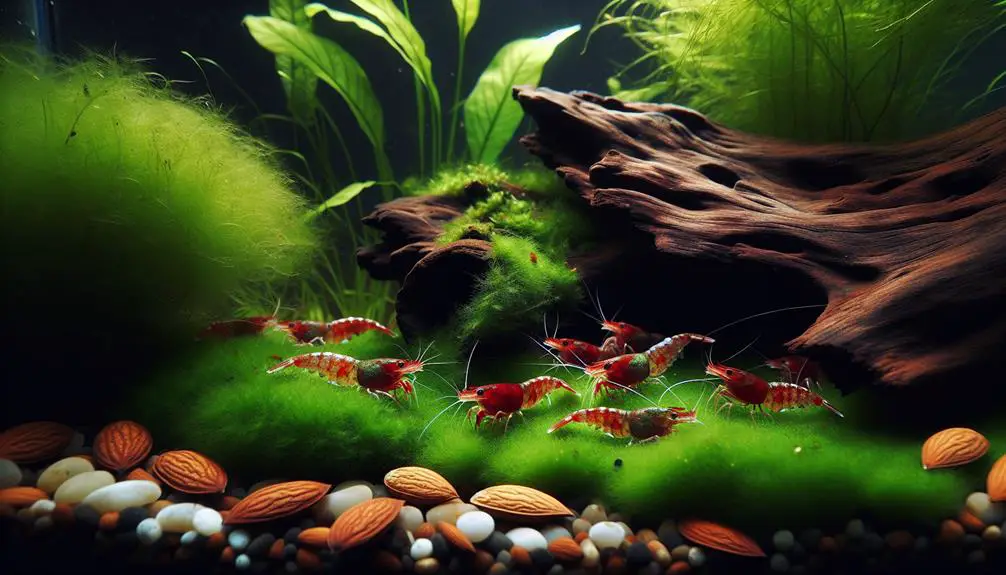
To sustain optimal health and coloration, red cherry shrimp require a diet that reflects their natural consumption of algae, biofilm, detritus, plant matter, and small insects.
Algae and biofilm as primary food sources are indispensable, providing a rich array of nutrients, including essential vitamins, minerals, and trace elements that are instrumental in maintaining robust immune responses and promoting vibrant coloration. The biofilm, a complex layer of microorganisms, supplies abundant proteins and lipids, which are crucial for growth and reproductive health.
The impact of such a natural diet on shrimp health is profound, with direct correlations observed between the quality of their diet and the intensity of their coloration.
Consequently, replicating this diet in a controlled environment is fundamental to cultivating thriving red cherry shrimp populations.
Commercial Foods Selection
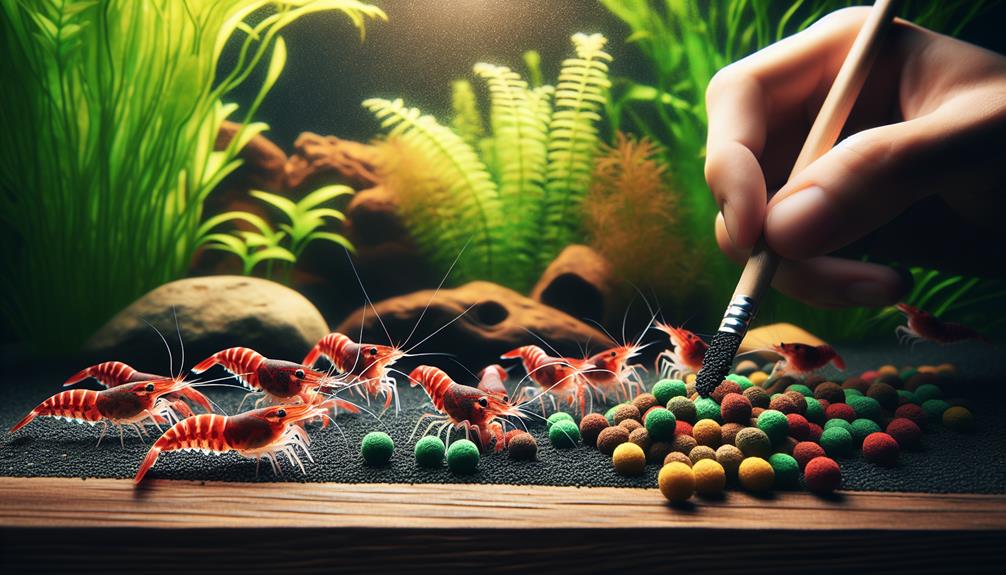
Selecting appropriate commercial foods for red cherry shrimp involves considering nutritional value, ingredient composition, and the shrimp’s natural dietary preferences to ensure their health and vitality. While commercial foods offer convenience, it is essential to deliberate on their pros and cons alongside homemade food options:
Commercial Foods Pros and Cons
- Easily accessible
- Formulated for balanced nutrition
- It may contain fillers or additives
Homemade Food Options
- Tailored to specific dietary needs
- Absence of artificial ingredients
- Requires time for preparation
Nutritional Requirements
- High-quality protein sources
- Essential minerals for exoskeleton development
- Vitamins to support overall health
An informed selection will cater to the shrimp’s well-being, promoting vibrant coloration and robust activity within the aquatic habitat.
Fruits and Vegetables Benefits
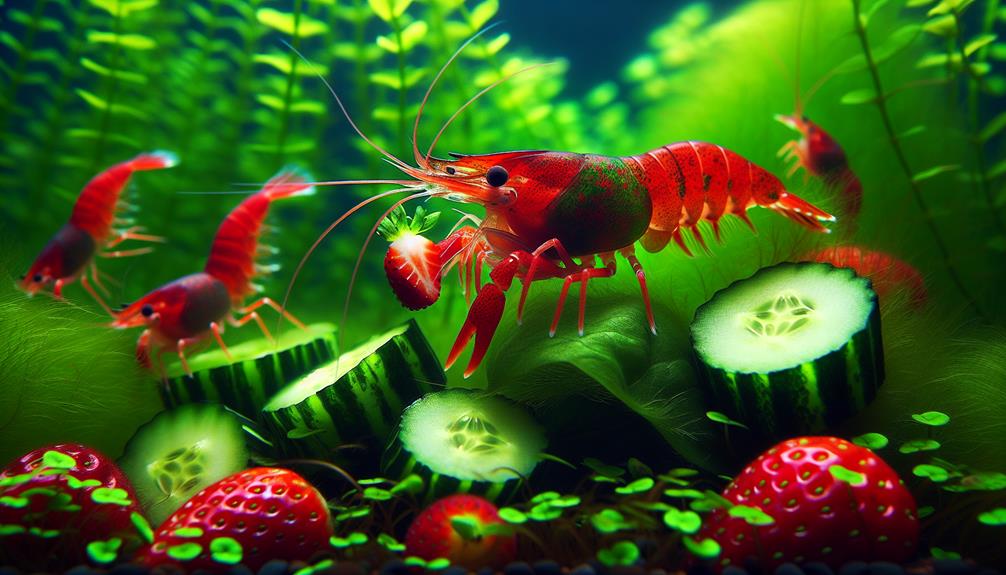
Incorporating fruits and vegetables into the diet of red cherry shrimp complements commercial food options by providing essential vitamins and minerals that support optimal health and growth. The benefits of feeding fruits and vegetables are manifold; they offer a varied nutritional profile that includes antioxidants, fibers, and essential trace elements. Such diversity is crucial for the shrimp’s immune system and vibrant coloration.
To incorporate fruits and vegetables into the shrimp’s diet, aquarists should introduce small, blanched pieces that are easy for the shrimp to consume. This method ensures the produce is palatable and safe, minimizing the risk of water contamination. Regularly rotating the types of fruits and vegetables provided can prevent nutritional deficiencies and promote a well-rounded diet, ultimately leading to a thriving shrimp colony.
Importance of Protein Sources
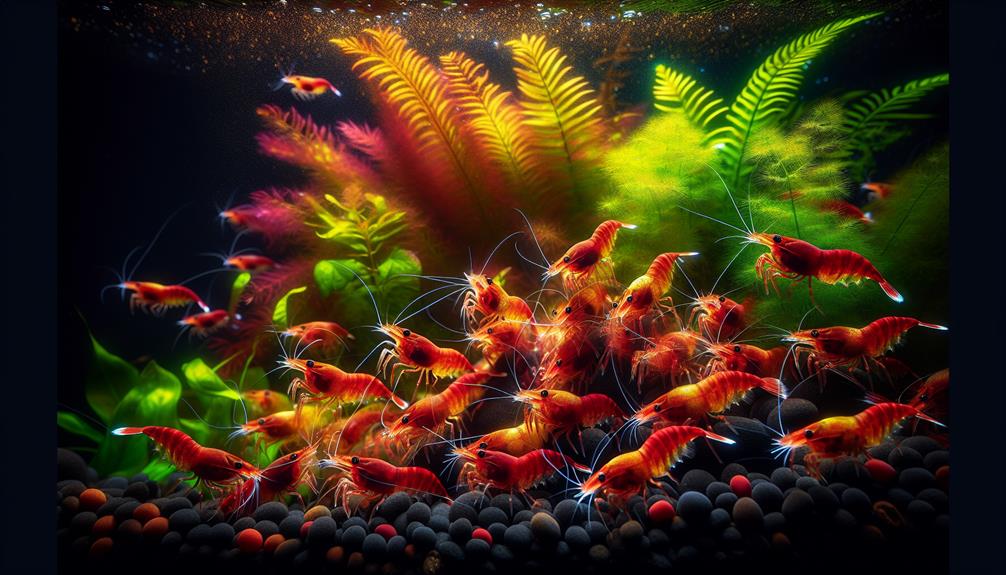
Protein is a crucial macronutrient in the diet of red cherry shrimp, serving as a building block for growth, repair, and overall vitality. Understanding and meeting protein requirements are essential for fostering a thriving shrimp colony. A balanced approach to protein provisioning is necessary to ensure optimal health and coloration.
Protein Sources for Red Cherry Shrimp:
- Natural Prey:
- Bloodworms
- Daphnia
- Commercial Foods:
- High-quality pellets
- Specialized flakes
- Alternative Protein Sources:
- Boiled egg yolk (sparingly)
- Soybean-based products
Incorporating various protein sources will cater to the dietary needs of the shrimp, providing essential amino acids. Alternative protein sources can also be introduced to diversify the shrimp’s diet and stimulate a more vibrant coloration and robustness within the population.
Essential Supplements Overview
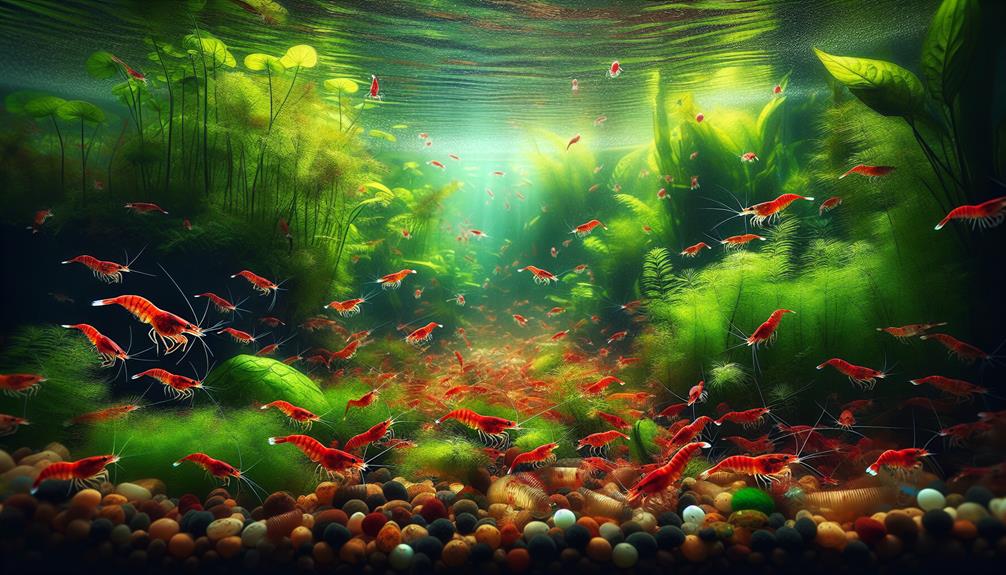
While a varied diet ensures red cherry shrimp receive their necessary protein, it is equally critical to address their need for specific vitamins and minerals through essential supplements. Ensuring these crustaceans flourish requires a regimented approach to providing supplemental food alternatives. These additives bolster overall health, fortify the shrimp’s vibrant coloration, and enhance reproductive success.
| Supplement Type | Emotional Benefit |
|---|---|
| Mineral Enrichers | Instills a sense of security for shrimp health |
| Vitamin Boosters | Fosters a nurturing environment for growth |
Feeding schedule tips include the judicious use of these supplements to prevent overloading the delicate ecosystem of your aquarium. The introduction of supplemental foods should be meticulously calculated, aligning with the shrimp’s natural consumption rates to avoid waste accumulation and ensure optimal nutrient absorption.
Conclusion
In conclusion, the vibrancy and health of Neocaridina davidi are closely linked to a diverse and balanced diet. Aquarists can ensure these invertebrates receive all necessary nutrients by emulating their natural feeding habits through a combination of algae, biofilm, and carefully selected commercial foods.
Incorporating vegetable and fruit matter, adequate protein sources, and essential supplements is imperative for robust growth and coloration. A strategic feeding regimen is key to sustaining a thriving Red Cherry Shrimp population.
